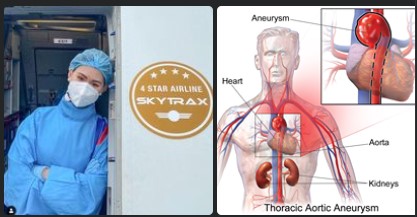By Dr. Willie Ong (Internist and Cardiologist)
Philstar.com reports that flight attendant Christine Angelica Dacera, 23, was pronounced dead in the hospital due to ruptured aortic aneurysm. However, police are still investigating foul play as the cause of death.
What is an aortic aneurysm?
The aorta is the largest artery in the body, around 3 centimeters in diameter. Its elastic wall is made up of three protecting linings.
However, if there is too much pressure inside the aorta (due to sudden increase in blood pressure), the inner part of the aorta (the intima wall) can tear up, thereby causing the blood to leak through the walls. This is known as an aortic dissection.
Who are at risk?
- The elderly – Usually, an aortic dissection does not occur spontaneously. Years of wear and tear on the aorta may cause this.
- Patients with high blood pressure – If the blood pressure is constantly above the upper limit of 140 over 90, this can initially lead to a ballooning of the aorta (called an aortic aneurysm), and later on, to an aortic dissection.
- Those with high cholesterol and smokers.
- Drug use such as cocaine and similar drugs – Cocaine causes aneurysms by weakening the inner lining of blood vessels. Cocaine increases blood pressure by tightening blood vessels (vasoconstriction). High blood pressure causes small tears on the inside of blood vessels.
- Traumatic injuries to the chest or abdomen.
- Hereditary causes like connective tissue disease, Marfan’s syndrome and others.
Symptoms of aortic aneurysm with dissection:
The main symptom is excruciating pain in the back or abdominal area, depending if the dissection is in the thoracic or abdominal aorta, respectively. Since the aorta supplies the arteries to the arms and legs, the patient may have weak pulses and unequal blood pressures. Dizziness, loss of consciousness, and numbness and paralysis of various parts of the body may also occur.
To diagnose aortic dissection, doctors request for a CT Scan or an MRI of the chest and/or abdomen.
Not a heart attack:
A common mistake is to label an aortic dissection as a heart attack. Although the patient may complain of the same back and chest pain, the two diseases are very different. A heart attack involves a blockage in the small arteries attached to the heart, while an aortic dissection involves a tear in the wall of the largest artery of the body.
Treatment:
Treatment of aortic dissection involves two strategies: aggressive medical therapy to lower the blood pressure and possible surgical intervention to repair the defect. Doctors prescribe drugs called beta-blockers to decrease the force of the heart’s pumping. Surgery may be needed in complicated cases.
Prevention Tips:
Have a healthy lifestyle to lower blood pressure and prevent aneurysms. Get a regular check up with your doctor if you have a family history of aneurysms. Aneurysms can be deadly if they are not caught and treated early. Take care.



